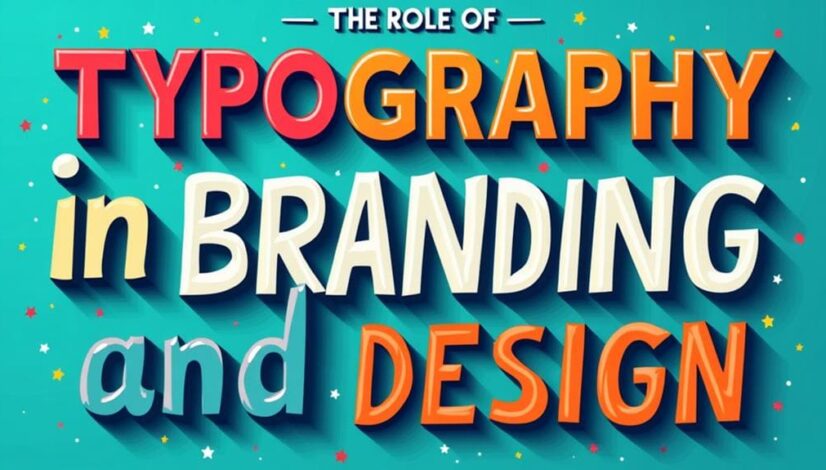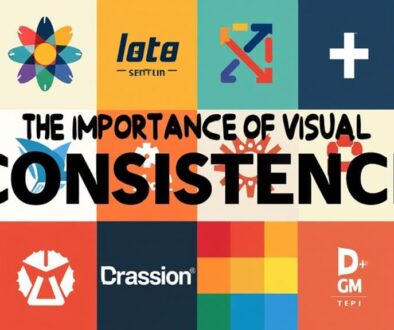The Role of Typography in Branding and Design
Typography plays a crucial role in branding and design, acting as the visual language of a brand. Each typeface carries emotional weight, influencing perceptions and fostering recognition. For instance, serif fonts evoke tradition, while sans-serif fonts suggest modernity. Consistent typography weaves a cohesive identity across various touchpoints, evoking feelings that resonate deeply with audiences. Legibility is paramount, ensuring messages are both accessible and impactful. By thoughtfully selecting fonts, brands can articulate their personality and values. Discovering the nuances of typographic choices reveals deeper insights into effective branding strategies and their emotional connections.
Key Takeaways
- Typography shapes brand identity, influencing perceptions and enhancing recognition through thoughtful font selection aligned with cultural significance.
- Choosing the right fonts sets the tone, with serif fonts conveying tradition and sans-serif fonts suggesting modernity, impacting audience engagement.
- Consistent typography across touchpoints fosters cohesive brand identity, enhancing user experience and building trust through visual language.
- Emotional resonance in font choices creates sensory experiences, evoking feelings that align with brand ethos and differentiating brands in the marketplace.
- Understanding font psychology is crucial, as different typefaces carry distinct connotations that affect readability, comprehension, and audience emotional responses.
Importance of Typography in Branding
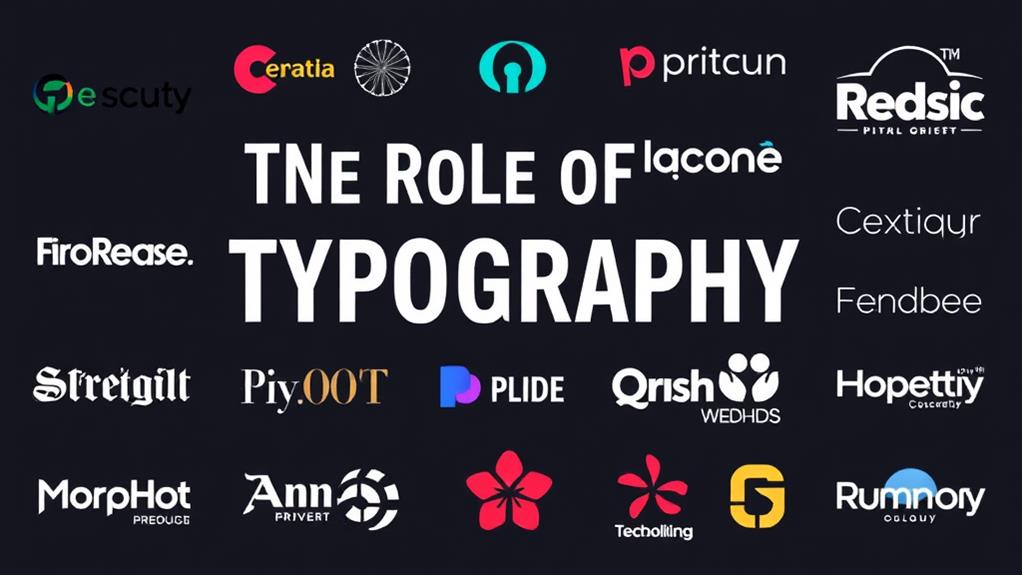
When I consider the impact of typography in branding, it becomes evident that it extends far beyond mere aesthetics; it is a powerful tool that shapes perceptions and communicates a brand's identity. Typography serves as a visual language, where font pairing and typographic hierarchy play essential roles in creating a narrative that resonates with audiences. By employing contrasting typefaces, brands can evoke emotions and establish a sense of hierarchy, guiding the viewer's attention through visual storytelling.
The cultural significance of typography cannot be overstated. Different fonts carry distinct connotations, and selecting the right typeface can enhance brand recognition and foster a deeper connection with target audiences. As design trends evolve, brands must adapt their typographic choices, balancing the allure of digital typography with the timelessness of print versus digital considerations. Effective font licensing guarantees that brands maintain legal integrity while exploring diverse typographic options.
Moreover, typography is instrumental in a brand's evolution. As brands grow, their visual identities may need refinement, requiring a thoughtful approach to font selection. This evolution must respect the foundational elements that contribute to brand recognition while embracing innovative design trends.
Ultimately, typography is not a mere embellishment; it is a strategic component of branding that encapsulates a brand's story, values, and aspirations, making it a crucial aspect of any branding strategy.
Choosing the Right Fonts
Selecting the right fonts for a brand is essential, as it sets the tone and influences the overall perception of the brand's identity. In a context where font pairing can either harmonize or clash, understanding modern trends and historical influences is vital. Serif fonts evoke tradition and reliability, while sans serif fonts convey a sleek, contemporary feel. The choice between these styles should reflect the brand's narrative and mission.
Cultural significance cannot be overlooked; fonts carry connotations that vary across regions and demographics. A well-chosen typeface resonates with the target audience, enhancing engagement and loyalty.
When considering digital vs. print applications, legibility factors become paramount. Fonts that are readable across platforms guarantee accessibility, accommodating diverse audiences, including those with visual impairments.
Custom typefaces can also play a pivotal role in brand evolution, providing a unique visual identity that sets a brand apart. However, the process of creating bespoke fonts should be balanced with accessibility considerations to avoid alienating potential customers.
Ultimately, choosing the right fonts is more than a design decision; it is a strategic move that shapes brand perception. By carefully considering font pairing, understanding the cultural and historical context, and prioritizing legibility, brands can forge a strong, coherent identity that stands the test of time.
In a time when typography can reflect a brand's ethos, the stakes are high, and the choice of typeface becomes a powerful tool in the branding arsenal.
Typography and Brand Personality
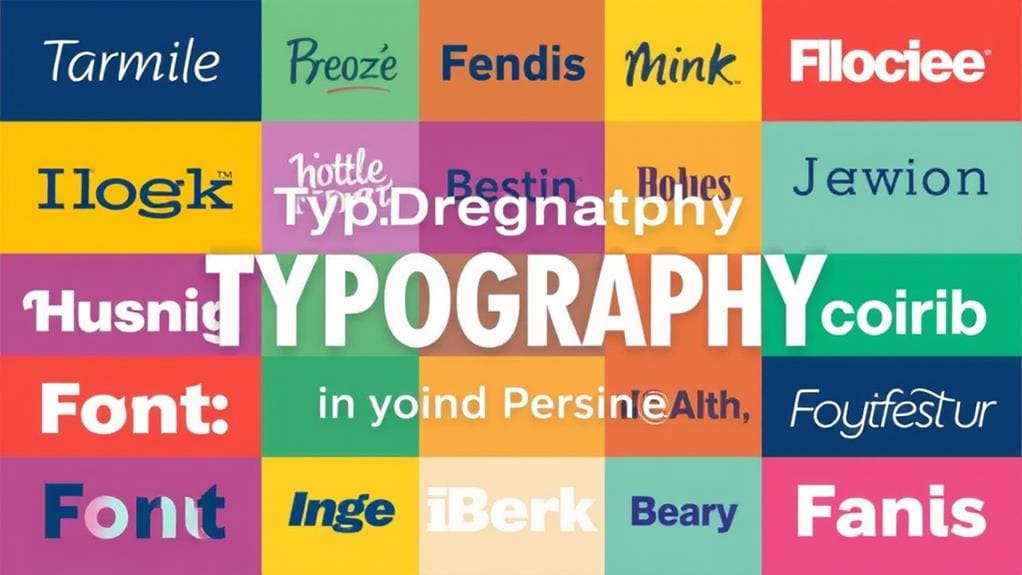
The choice of typeface is more than a mere aesthetic decision; it serves as a crucial conduit for conveying a brand's personality.
Each font carries emotional weight, influencing how audiences perceive and connect with a brand's values and ethos.
Consistency in typography across all touchpoints solidifies this emotional resonance, fostering a cohesive identity that resonates with consumers.
Typeface Selection Impact
Typeface selection plays a pivotal role in shaping a brand's personality, influencing perceptions and emotional responses with each letterform. The choice of typeface can greatly impact brand recognition, acting as a visual anchor that resonates with target audiences.
As typeface trends evolve, brands must navigate this landscape to maintain relevance while embodying their core values.
Consider the following factors when selecting a typeface:
- Brand Identity: Choose a typeface that aligns with your brand's voice—serif fonts often convey tradition, while sans-serif fonts can suggest modernity.
- Target Audience: Understand the demographic you are aiming to attract; playful fonts might engage younger audiences, whereas more sophisticated options appeal to professionals.
- Legibility: Confirm that your typeface is easily readable across various mediums, from digital screens to print collateral.
- Consistency: A cohesive typographic palette reinforces brand recognition, making your messaging instantly identifiable across all platforms.
Incorporating these elements into your design strategy not only enhances aesthetic appeal but also fortifies your brand's presence in a competitive market.
The right typeface is a powerful tool for storytelling and connection.
Emotional Resonance of Fonts
Emotional resonance is a fundamental element in the relationship between typography and brand personality, as fonts possess the unique ability to evoke feelings and associations that align with a brand's ethos. The symbolism inherent in typefaces plays a critical role in shaping font perception; for instance, serif fonts often evoke tradition and reliability, while sans-serif fonts may convey modernity and simplicity.
Understanding the cultural significance of fonts enhances brand storytelling, as different audiences may respond uniquely to typeface emotions. Emotional typography creates an immediate sensory experience, allowing brands to forge deeper emotional connections with their audience.
Design aesthetics further amplify this emotional resonance by establishing a visual hierarchy that guides viewer attention and shapes perception. A well-considered typeface selection can make or break a brand's identity, as it encapsulates the core values and personality traits that the brand wishes to convey.
Ultimately, the emotional connection fostered through thoughtful typography not only enhances brand differentiation but also cultivates loyalty, as consumers begin to associate specific feelings with their experiences of a brand.
Consequently, mastering the nuances of emotional resonance in typography is essential for compelling branding.
Consistency Across Touchpoints
Consistent typography across all brand touchpoints is essential for establishing a cohesive brand identity that resonates with consumers. Typography serves as a visual language that communicates brand personality, reinforcing the emotional connection between the brand and its audience.
Adhering to typography guidelines guarantees that every interaction—whether digital or print—maintains design cohesiveness and enhances user experience.
To achieve effective typography consistency, consider the following:
- Font Pairing: Select complementary typefaces that reflect the brand's character while maintaining legibility across various applications.
- Visual Hierarchy: Establish a clear hierarchy through font sizes and weights to guide the viewer's attention and convey information effectively.
- Cross Platform Consistency: Ascertain that typography remains consistent across all platforms, including websites, social media, and print applications, to unify the brand's digital presence.
- Branding Material: From brochures to banners, typography should be aligned with the overall branding material to cultivate familiarity and trust.
The Psychology of Fonts
Fonts are more than mere letters; they evoke emotions and shape perceptions in the viewer's mind.
The choice of typography can enhance readability and comprehension, influencing how a message is received and understood.
Additionally, fonts can embody brand personality, creating a visual language that resonates deeply with audiences and establishes lasting connections.
Font Associations and Emotions
Harnessing the power of typography, designers tap into the intricate relationship between font choices and human emotions. Each font embodies unique symbolism, evoking a spectrum of feelings that can influence brand perception and audience engagement.
The beauty of font diversity lies in its ability to convey messages not just through words, but through aesthetic appeal and emotional triggers.
Consider these associations:
- Serif Fonts: Often convey tradition and reliability, making them ideal for established brands.
- Sans-Serif Fonts: Evoke modernity and cleanliness, appealing to a younger, tech-savvy audience.
- Script Fonts: Infuse warmth and creativity, often used for brands focusing on elegance and personal touch.
- Display Fonts: Capture attention with their boldness, perfect for emphasizing key messages within visual hierarchy.
Understanding the cultural significance of fonts is essential in aligning design trends with target audience expectations. By leveraging font symbolism, designers can enhance message conveyance, ensuring that emotional resonance aligns with brand narrative.
Ultimately, the intelligent choice of typography can transform a simple design into a compelling emotional experience, fostering deeper connections with the audience.
Readability and Comprehension Impact
Typography serves as the silent yet powerful backbone of written communication, influencing not just aesthetics but also the efficacy of message delivery. The interplay of text clarity and visual hierarchy shapes reading speed and enhances comprehension, making the choice of font critical. A well-crafted layout influences how information is processed, directly impacting cognitive load.
By optimizing font accessibility, designers can guarantee that their messages are easily digestible, inviting greater audience engagement. Incorporating a balanced design approach allows for seamless navigation through content, fostering message retention.
When users can swiftly interpret text, brand recognition flourishes; the familiarity of a well-presented message resonates deeper in the minds of consumers. Each typographic decision—spacing, size, and style—contributes to an overall aesthetic that can either captivate or alienate the reader.
Thus, the role of typography transcends mere decoration; it becomes an essential element in crafting an enduring connection between the brand and its audience. By prioritizing readability and comprehension, brands can communicate effectively, guaranteeing their message not only reaches but also resonates with their intended demographic.
Brand Personality Through Typography
Choosing the right typeface can substantially shape a brand's personality, allowing it to stand out in a crowded marketplace. Typography serves not only as a visual identity but also as a narrative tone that resonates with target audiences.
The psychology of fonts can enhance brand storytelling through character expression and design ethos, enabling effective brand differentiation.
To masterfully harness typography for brand personality, consider the following elements:
- Typographic Hierarchy: Establish a clear hierarchy to guide viewers through the visual narrative, emphasizing key messages.
- Font Pairings: Combine complementary typefaces to create aesthetic alignment, ensuring coherence and sophistication in visual communication.
- Cultural Significance: Recognize the cultural weight of specific fonts, as they can evoke emotion and convey meaning that transcends language.
- Character Expression: Choose typefaces that embody the essence of your brand, reflecting its traits, values, and audience expectations.
Consistency in Typography
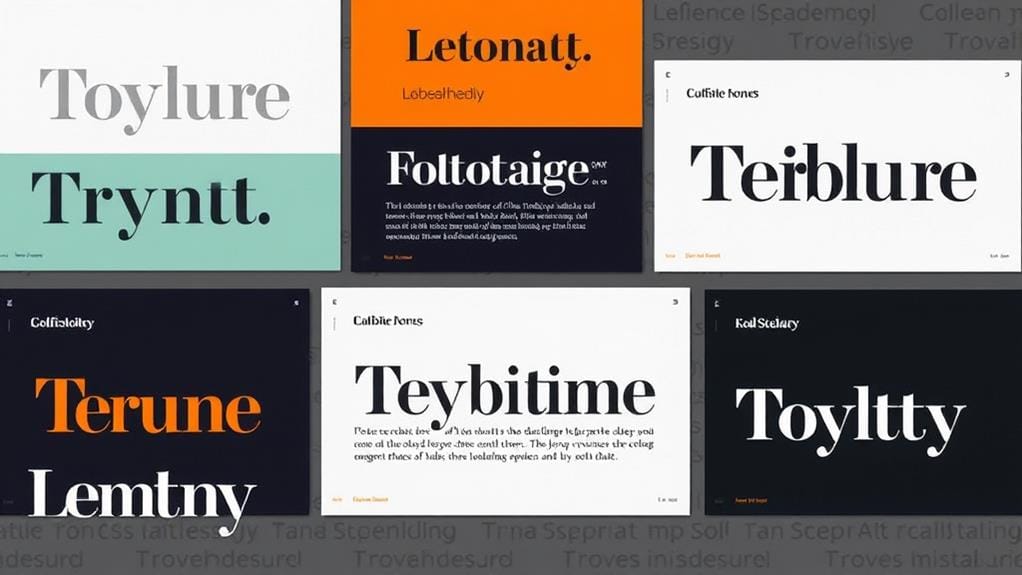
In the domain of branding and design, the significance of consistency in typography cannot be overstated. It is the backbone that supports a brand's identity, weaving together various design elements into a cohesive narrative. Achieving visual coherence through consistent typographic choices enhances brand recognition and fosters trust with the audience. A well-structured typographic hierarchy clarifies the message, guiding the viewer's eye and ensuring crucial information is emphasized, thereby improving the overall user experience.
Integrating consistent font pairings, as outlined in detailed style guides, is essential for maintaining this coherence. These guides serve as a roadmap, dictating which typefaces should be used in various contexts—whether in digital formats or print. This consistency extends to logo integration, where typography not only represents the brand but also aligns with its cultural significance and evolving narrative.
Moreover, the choice of typefaces contributes to a brand's evolution; as brands adapt to market trends, their typographic choices must reflect both continuity and innovation. In this balance lies the power to evoke emotions and establish a lasting connection with the audience.
Consequently, mastering the art of consistent typography is not merely an aesthetic endeavor but a strategic imperative that influences how a brand is perceived and remembered. By ensuring that every typographic choice aligns with the brand's ethos, designers create an indelible mark that resonates through time and space.
Case Studies and Examples
Successful branding often hinges on the careful selection and application of typography, as demonstrated by various case studies across industries. These examples illustrate how thoughtful font pairings and an understanding of historical influences can elevate a brand's identity and resonance.
- Coca-Cola: The iconic Spencerian script not only embodies nostalgia but also evokes a sense of happiness and refreshment. This font choice has remained consistent since the late 19th century, enhancing brand recognition worldwide.
- Apple: The sleek, modern typography used in Apple's marketing materials, particularly the San Francisco font, reflects its commitment to innovation and aesthetic simplicity. The pairing of sans-serif fonts with minimalist design reinforces its brand ethos of sophistication.
- Nike: The bold, sans-serif typography in Nike's branding communicates strength and athleticism. Its pairing with the swoosh symbol creates a powerful visual identity that resonates with its target audience, furthering the message of performance.
- The New York Times: The use of the historic "Frank Ruhl Libre" typeface in its print and digital formats conveys authority and tradition. This careful selection of type aligns with the publication's commitment to journalistic integrity and heritage.
These case studies highlight the profound impact of typography in branding. By understanding font pairings and their historical influences, brands can craft identities that not only stand out but also resonate deeply with their audiences.
Frequently Asked Questions
How Do Cultural Differences Affect Typography Choices in Branding?
Cultural differences greatly influence typography choices, as various societies attribute distinct cultural symbolism to specific fonts and styles.
For instance, Western cultures may favor modern sans-serif fonts for a contemporary feel, while Eastern cultures might prefer traditional script fonts that evoke heritage.
Additionally, font preferences can vary based on factors such as readability, emotional resonance, and aesthetic appeal, necessitating a nuanced approach to typography that respects and reflects diverse cultural narratives in branding initiatives.
Can Typography Impact Website Loading Speed?
Imagine a website so beautiful yet so slow that it drives users away in frustration!
Typography plays an essential role here; poor font optimization can dramatically hinder web performance. When web fonts are not efficiently loaded, they can bloat page size, leading to longer loading times.
What Are the Legal Considerations With Font Licensing?
When considering font licensing, it is vital to understand font ownership and the intricacies of licensing agreements.
Each font may have specific terms dictating its usage, including restrictions on modification and distribution.
Failure to adhere to these agreements can lead to significant copyright implications, potentially resulting in legal disputes or financial penalties.
Therefore, mastering the nuances of font licensing is essential for professionals to guarantee compliance and protect intellectual property within their projects.
How Can Typography Improve Accessibility for Users?
Typography is the bridge that connects content to comprehension, ensuring messages resonate with all users.
By employing ideal font size, enhancing color contrast, and adhering to established readability standards, designers can create text that is accessible to diverse audiences.
This commitment to inclusive design not only fosters a welcoming environment but also empowers individuals with varying abilities, ensuring that every word contributes to a richer understanding of the material presented.
Are There Specific Fonts to Avoid in Branding?
When considering branding, it is essential to avoid overused fonts such as Times New Roman and Comic Sans.
These fonts can detract from brand perception, leading to a lack of originality and professionalism.
Opting for unique typefaces fosters a distinct identity, enhancing recognition and emotional connection with the audience.
A well-chosen font not only differentiates a brand but also communicates its values and ethos effectively, creating a lasting impression in a competitive marketplace.
Conclusion
To sum up, typography serves as a fundamental pillar in branding and design, influencing perceptions and emotional responses. For instance, a luxury brand utilizing elegant serif fonts evokes sophistication, while a playful startup may opt for bold, rounded sans-serif typefaces to convey approachability. Such deliberate choices shape brand identity and consumer connection. Ultimately, effective typography transcends mere aesthetics, creating a lasting impact that resonates deeply with audiences, reinforcing brand recognition and loyalty in an increasingly competitive landscape.
